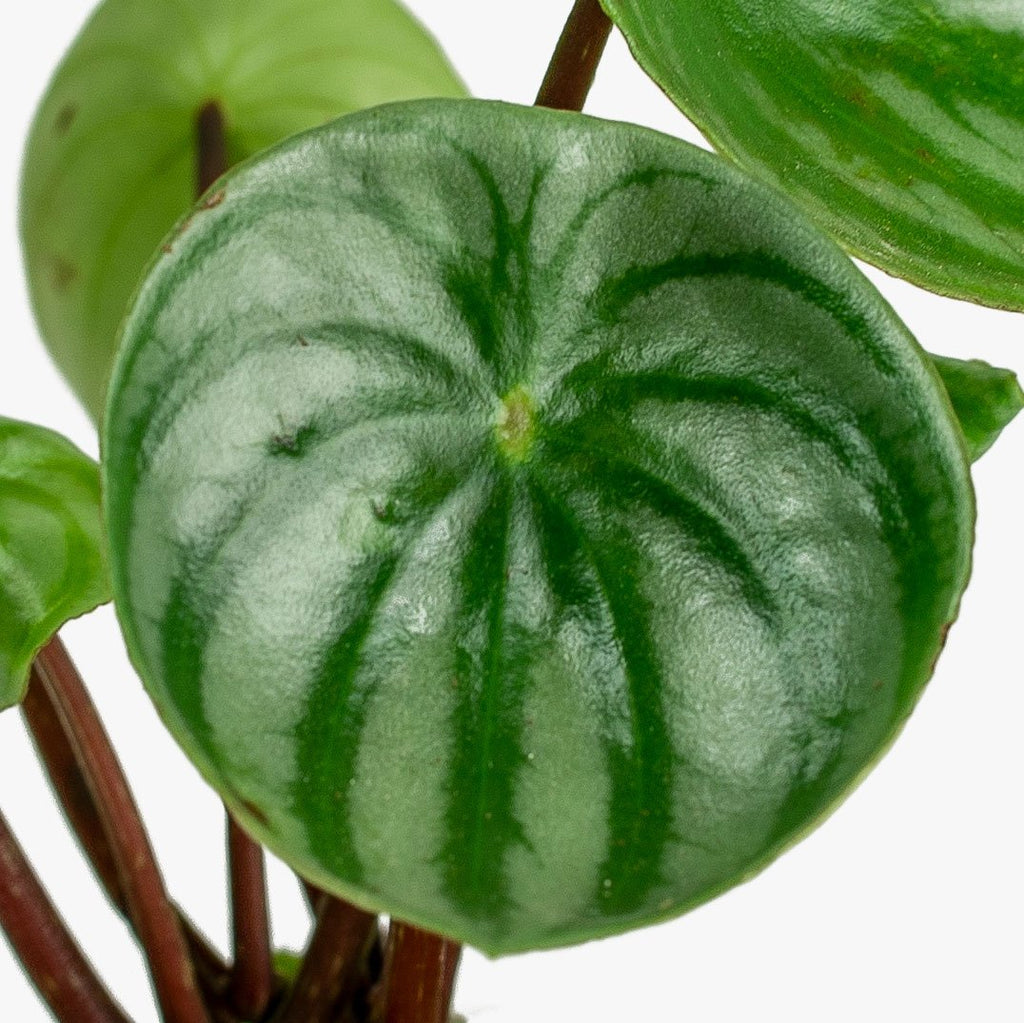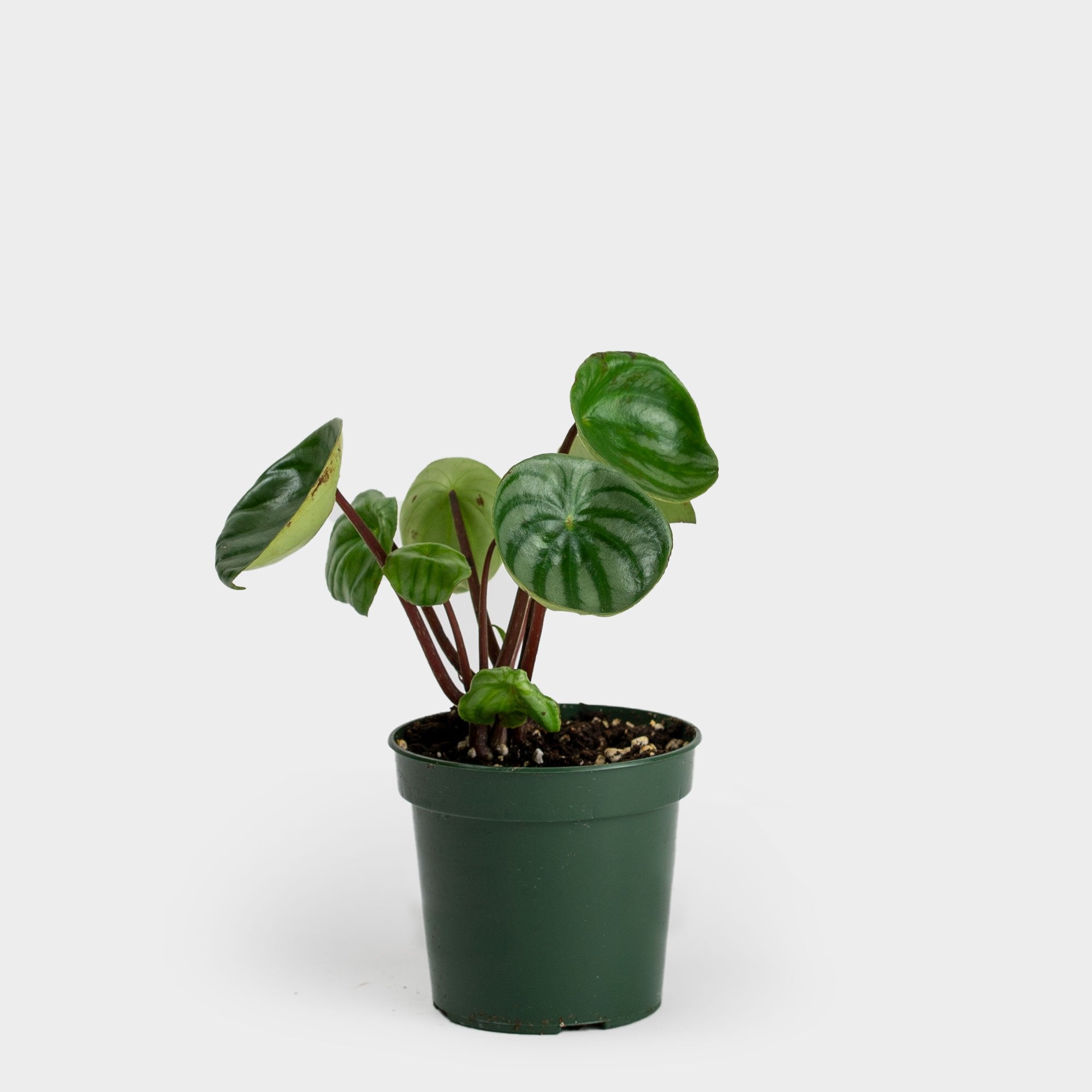Peperomia Care
Placement
PRO TIP: When in doubt, let it drought! Peperomia are very susceptible to root rot, so it’s best not to overwater.
Peperomia are a large genus of about 1700 known species of tropical plants. Their natural growing habitats are the tropics of Central and South America, and parts of Asia. They range in appearance greatly, but in general are small flowering plants with plump even succulent-like leaves. Peperomia do not like direct sunlight so they are best placed near a window receiving bright indirect or filtered sun. Some varieties can tolerate medium light conditions, and most will grow well under grow lights alone. The thicker leaved species do not require as much humidity as those with thin delicate leaves, which may be best kept in a terrarium or a bathroom.
If you are unsure of the lighting conditions in your home or office, we have a guide for how to measure light in your space.

The leaves of the Watermelon Peperomia are thick, round and striped with silvery green splashes.
Routine Maintenance
PRO TIP: Rotate your plant frequently to keep its growth even and symmetrical!
Always be sure to assess your plant’s watering needs upon receiving it. Before giving your plant a drink, it is best to check the moisture level in the soil first. Peperomia prefer a good drying out period between waterings. For varieties with more succulent-like leaves they may like to dry almost all the way through the pot between waterings, and can tolerate dryer conditions overall. Although during the growing seasons their water intake may increase. For fleshy or softer leaved varieties, allow the soil to dry ⅓ of the way through the pot between waterings.Peperomia are sensitive to overwatering and root rot, and therefore appreciate a well draining soil. The watering needs of Peperomia can vary depending on the unique environment they are growing in and depending on the needs of the exact species. Consider aerating the soil of your plant before the initial watering. We compact the soil to avoid shifting during transit, so aerating can help the soil breath and allow for moisture to be released.
Frequently Asked Questions
How can I tell if my Peperomia is being overwatered?
- Common symptoms of overwatering can be leaf loss, browning edges of the leaf preceded by a yellow edge, and browning mushy stalks. If you see any of these symptoms, check the soil to see if it is moist. To help the soil dry out aerate and hold off on watering until the soil dries completely, then resume an appropriate watering routine
How can I tell if my Peperomia is being underwatered?
- Common symptoms of underwatering are leaf loss, fully yellowing leaves that fall, and brown crispy leaf margins. If you see any of these symptoms feel the soil of your plant to assess if it is dry, and therefore matches the diagnosis.
How do I propagate my Peperomia?
- Peperomia are very easy to propagate! Below are two methods.
- Soil Method: Cut the Peperomia along the petiole (stem) and plant it into soil. Water more often than usual until roots develop. Use rooting hormone if desired but it is not necessary.
- Water method: Take a leaf cutting and let the stem sit in water until a good amount of roots appear. Transfer to a small pot and provide care as usual.
How often should I fertilize my plant?
- In general, houseplants will thrive when they are fertilized spring through fall. Fertilize once a month with an organic houseplant fertilizer, following the package instructions for dilution and administration. Greenery NYC uses an organic potting mix with a slow release fertilizer in the soil, so your plant will not need fertilizer within the first 6 months of receiving it.
How often does my plant need to be repotted?
- For larger floor plants, we suggest repotting every 18-24 months. Typically you want to choose a potting vessel 2”- 4” larger in diameter to allow for growth. Don’t choose a pot much larger than the previous as this could drown the plant's roots. If you prefer to maintain the current size of your plant, repot into the same vessel, providing new soil and trimming away some roots and foliage. Spring or summer is the ideal time to repot as the plant is at its strongest.
Standard Planter Instructions
All of our Standard Planters include a removable drainage plug to give our customers the option of drainage. While no drainage is sometimes preferred for its aesthetic simplicity, we don't recommend this option for beginners as watering mistakes can be hard to rectify.
Whether you choose to use drainage or not, we always recommend using a layer of drainage (such as our Aeration Stones) at the base of the planter. A drainage layer allows the plant's roots access to oxygen in the pockets between the drainage medium, and a lack of drainage can cause anaerobic damage to your plant.
If you decide to utilize the drainage hole for your pot, make sure to include a Plant Saucer beneath your pot to collect excess water. For most plants in standard planters, we recommend watering about once a week. Water the soil mass until water begins pooling in your Plant Saucer.
With no drainage hole, you will need to be more precise in your watering. While we would love to give you a specific measurement of water to provide for your plant, the reality is that a plant's water requirements vary wildly depending on factors such as light exposure and the overall health of the plant. You will need to learn to tell when the plant is thirsty based on how its foliage looks. Droopy foliage is usually the first sign: when your plant looks a little slumped over that's usually a visual indicator that it's thirsty.
The best solution for checking your plant's moisture level, drainage hole of not, is to use a Soil Probe to determine the moisture content of the soil at the bottom of the planter.
Self Watering Planter Instructions
The Self-Watering Planters require a deep and thorough watering of the topsoil after they are first planted. This is important because the roots of the plants first need to grow into the reservoir in order to drink from it. Water your plant from the top for two to four weeks before using the reservoir. During the dormant seasons, or for plants that have slower growing habits, consider top watering for longer.
TEST: After the initial top water period, fill the bottom water reservoir. If the water in the reservoir is absorbed into the planter, it means the plant is ready for regular reservoir servicing. If not, be sure to continue top watering for a few more weeks until the plant has started drinking from the reservoir.
RESERVOIR SERVICING: Once the reservoir empties on its own, do not refill the reservoir right away. Similar to how humans need a breath of air between gulps of water, most plants require a drying out period. Allow for the reservoir to empty all the way between watering. All plants are different in their needs so the amount of time the reservoir sits empty will need to be determined, but know that for most plants this period is between 1-3 days.
From here on out, you should rarely topwater the plant while using the reservoir system. Watering from below allows the plant to drink at its own pace, and can help combat certain issues like fungus gnats by allowing the top layer of soil to dry out more. Please note that if your plant's soil dries out too much, it can impair the wicking ability of the Aeration Stones in your planter. If your soil becomes too dry, we recommend giving it a thorough watering.
For more information on our Self Watering Planters include planting instructions, visit our blog post on How to Use Our Self-Watering Pots.
Recommended Accessories
Aeration Stones
Aeration Stones promote healthy root growth by creating air pockets in the soil and absorbing excess water in the basin of your planter. These porous clay stones are a natural, efficient and invaluable material to set your plant up for success. We always suggest using these when working with a planter without drainage holes.
ARS Stainless Steel Pruners
Salts and moisture from potting soil wreaks havoc on cheaper metals. Stainless steel is one of the most durable metals available on a consumer scale, and these heavy duty pruners are built to take a beating. Great for pruning jobs large and small.
Neem Oil
Neem Oil is an all purpose insecticide, miticide, and fungicide used for organic gardening. It's systemic, which means the plant will absorb the neem oil into its circulatory system and poison pests from within. Be careful not to overuse, as this can weaken plants and cause discoloration.
Soil Probe
Plants do poorly without air to the roots. Overwatering causes the air to be pushed out of the soil, compacting the soil around the waterlogged roots of the plant. Using the Soil Probe aerates the soil as it checks for moisture.
Watering Can
Watering cans come in all shapes and sizes, and the perfect one for your home is the one you're happiest living with. Look for long spouts and a container volume that's appropriate for your plant collection.
Soil
Fox Farm Ocean Forest contains all the features we look for when aiming to ensure the long term health of a plant: excellent water retention, breathability, texture, and is made from organic materials.
Fertilizer
10-4-3 fertilizer is a great, gentle choice for indoor foliage. Simply mix this in to your watering can using the supplied directions every other week. Ensure that your plant is receiving a good amount of light, otherwise it won't have the energy to process the nutrients and burnt tips may occur on the foliage.
Cork Mats
Protects furniture and floors from scratches and moisture. HIGHLY RECOMMENDED for use with planters made from organic materials such as ceramic.




